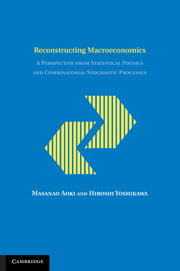 Reconstructing Macroeconomics
Reconstructing Macroeconomics Book contents
- Frontmatter
- Contents
- Preface by Masanao Aoki
- Preface by Hiroshi Yoshikawa
- 1 Introduction: A New Approach to Macroeconomics
- 2 The Methods: Jump Markov Process and Random Partitions
- 3 Equilibrium as Distribution: The Role of Demand in Macroeconomics
- 4 Uncertainty Trap: Policy Ineffectiveness and Long Stagnation of the Macroeconomy
- 5 Slow Dynamics of Macro System: No Mystery of Inflexible Prices
- 6 Business Cycles: An Endogenous Stochastic Approach
- 7 Labor Market: A New Look at the Natural Unemployment and Okun's Law
- 8 Demand Saturation-Creation and Economic Growth
- 9 The Types of Investors and Volatility in Financial Markets: Analyzing Clusters of Heterogeneous Agents
- 10 Stock Prices and the Real Economy: Power-Law versus Exponential Distributions
- References
- Author Index
- Subject Index
- Other books in the series (continued from page iii)
2 - The Methods: Jump Markov Process and Random Partitions
Published online by Cambridge University Press: 08 August 2009
- Frontmatter
- Contents
- Preface by Masanao Aoki
- Preface by Hiroshi Yoshikawa
- 1 Introduction: A New Approach to Macroeconomics
- 2 The Methods: Jump Markov Process and Random Partitions
- 3 Equilibrium as Distribution: The Role of Demand in Macroeconomics
- 4 Uncertainty Trap: Policy Ineffectiveness and Long Stagnation of the Macroeconomy
- 5 Slow Dynamics of Macro System: No Mystery of Inflexible Prices
- 6 Business Cycles: An Endogenous Stochastic Approach
- 7 Labor Market: A New Look at the Natural Unemployment and Okun's Law
- 8 Demand Saturation-Creation and Economic Growth
- 9 The Types of Investors and Volatility in Financial Markets: Analyzing Clusters of Heterogeneous Agents
- 10 Stock Prices and the Real Economy: Power-Law versus Exponential Distributions
- References
- Author Index
- Subject Index
- Other books in the series (continued from page iii)
Summary
The new approach to macroeconomics and financial markets outlined in Chapter 1 requires mathematical methods and concepts that are quite different from those commonly used in economics. This chapter introduces them to the reader.
Phenomena we can analyze using the methods explained here share one or more of the following three features:
A finite but large number of micro units or agents interact.
Different “types” of agents are present.
New and unknown types of agents, products, or technologies may appear; that is, the number of types of agents, products, or technologies may not be fixed nor known in advance.
To analyze these phenomena, we must depart from the standard methods of model construction and analysis in mainstream economics. Specifically, in this book, we formulate models as continuous-time Markov chains, also known as jump Markov processes. This approach gives us new insight, and often yields more information on the behavior of the macroeconomy than the traditional approach can offer.
The standard approach in “micro-founded” macroeconomics formulates complicated intertemporal optimization problems facing the representative agent. By so doing, it ignores interactions among nonidentical agents. Also, it does not examine a class of problems in which several types of agents simultaneously attempt to solve similar but slightly different optimization problems with slightly different sets of constraints. When these sets of constraints are not consistent, no truly optimal solutions exist.
- Type
- Chapter
- Information
- Reconstructing MacroeconomicsA Perspective from Statistical Physics and Combinatorial Stochastic Processes, pp. 28 - 57Publisher: Cambridge University PressPrint publication year: 2006
- 1
- Cited by


